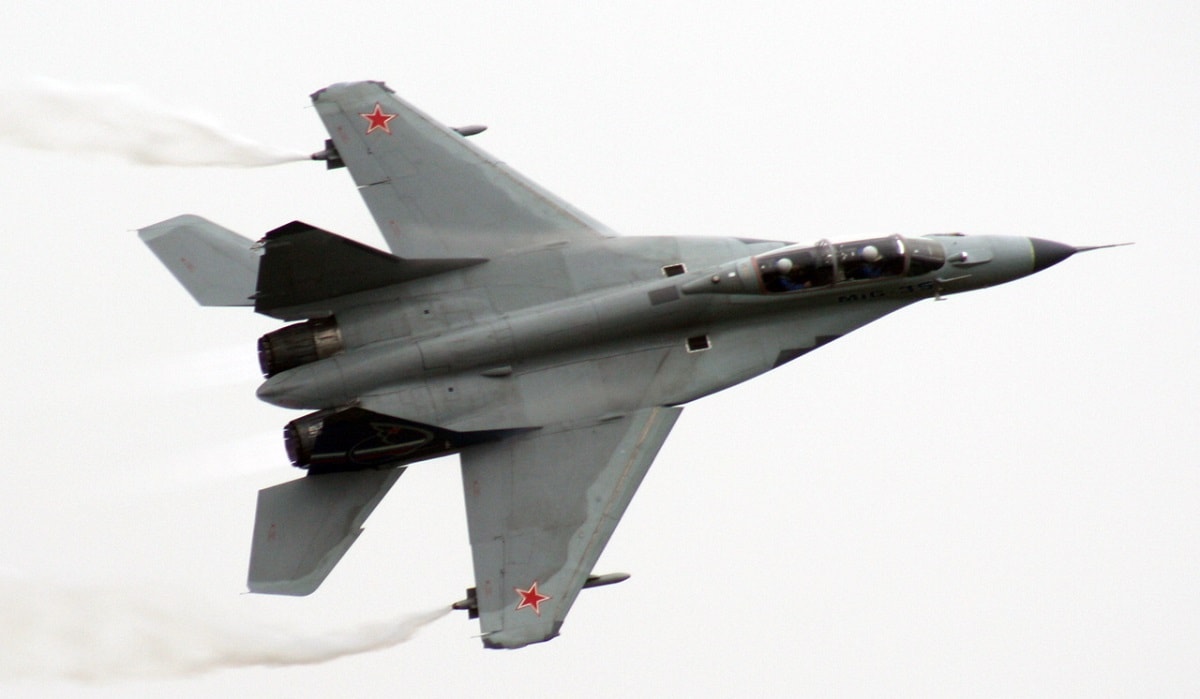The MiG-35 Fulcrum-F is one of Russia’s most modern aircraft. Yet little is known about the project, and the warplane’s development has not gone entirely as planned. Jammed in the Russian defense industry’s crowded development queue, it is unclear whether or when the MiG-35 will emerge as a concrete element of the Russian Aerospace Forces. For now, it is a project whose horizon is unclear.
Fourth Generation and Then Some
Russia’s MiG-35 is billed as a highly advanced, fourth-generation multirole aircraft that makes use of fifth-generation technologies.
Marketed as a “fourth generation ++” fighter, the MiG-35 is an evolved mashup of the MiG-29K/KUB and MiG-29M/M2. The Fulcrum-F has been under development since the early 2000s, and it was publicly revealed in 2007. Russia’s Mikoyan design bureau, which is a subsidiary of the United Aircraft Corporation, is developing the aircraft.
Russian defense officials claim that the avionics, targeting, and defense systems of the Fulcrum-F will set the MiG-35 apart from older Russian aircraft, but it is impossible to verify these upgrades.
The two principal configurations of the MiG-35 are the aircraft’s single- and double-seat options, known as the MiG-35 and MiG-35D respectively. There are no major differences between these two versions of the Fulcrum-F, as both rely on two Klimov RD-33MK engines and can carry the same number of missiles, bombs, and other weapons.
With a maximum speed of 1,590 miles per hour, the MiG-35 has rough parity with many comparable multirole aircraft. A MiG-35 is reportedly capable of carrying a variety of modern rockets, air-to-air missiles, and air-to-surface missiles, as well as guided and unguided missiles and bombs, with its nine separate hardpoints. The Fulcrum-F was also announced as the first Russian military aircraft to include an active electronically scanned array radar system.
Is the MiG-35 a Paper Tiger?
While Russia’s MiG-35 appears on paper to be a formidable multirole fighter aircraft, Russia’s lack of progress has made it difficult for outside observers to objectively evaluate its performance – or for the Russian Aerospace Forces to utilize it at scale.
In 2013, Russia’s air force announced that it would order 37 MiG-35 Fulcrum-Fs, but only six prototypes and eight serially produced MiG-35s have been finished. According to Musheg Baloyan, the head of Mikoyan’s MiG-29M, MiG-35 and Light Multi-Purpose Frontline Aircraft Programs Directorate, the MiG-35 is undergoing its final stage of trials. But this has not pushed the Russian government – or any other potential customers – to place significant orders for the Fulcrum-F.
The MiG-35 is competing to fulfill India’s 114 multi-role fighter aircraft project. Here, it faces stiff competition from a variety of entries: the French Rafale; the American F-18, F-15; the Eurofighter Typhoon; the Saab Gripen; and its Russian cousin, the Su-35. Egypt’s government had shown interest in purchasing the MiG-35, but Cairo ultimately inked a deal with Russia to purchase 46 MiG-29s in 2015. Russia’s defense export agency, Rosoboronexport, has also reportedly expressed its interest in entering the MiG-35 into Malaysia’s competition for a new jet trainer.

Without a guaranteed stream of orders to sustain and justify further development of the MiG-35, it is not a surprise that the aircraft has been overshadowed by other Russian planes that play a similar role. Unless interest for the Fulcrum-F picks up in the future, it is hard to imagine that the MiG-35 will enter active service at scale.
Wesley Culp is a Research Fellow at the Center for the Study of the Presidency and Congress. He regularly writes on Russian and Eurasian leadership and national security topics and has been published in The Hill and the Diplomatic Courier. He can be found on Twitter @WesleyJCulp.

